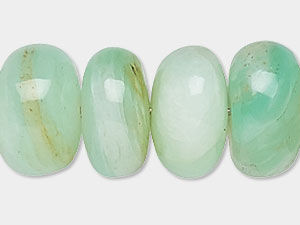Opal, Peruvian Meaning and Properties
Peruvian Opal History
Peruvian Opal History
This specific type of opal is the national stone of Peru. Found only in the Andes mountains, Peruvian opal is a relatively rare and treasured variety of common opal. It’s believed to be a gift from Pachamama, the early Incan goddess of Earth and time. Unlike other opals known for fiery flashes, Peruvian opal is admired for its gentle iridescence and soothing color palette.
The most recognized variety is blue Peruvian opal, often compared to the tranquil waters of the Caribbean. These stones can sometimes contain black dendritic inclusions, adding visual texture and intrigue. Recent findings also highlight that pink opal—another variety sourced from Peru—shares the same origins but features a delicate, rosy hue. Revered in ancient Andean cultures, pink Peruvian opal meaning was associated with peace, emotional healing and spiritual connection.
To learn more about the different types of opals, view the opal meaning and properties article.
What are the Metaphysical Properties of Peruvian Opal?
It’s no surprise that blue Peruvian opal, with its ocean-like tones, is said to carry a calming and nurturing energy. According to metaphysical beliefs, this opal is used to release tension, support emotional healing and promote peaceful sleep. Blue Peruvian opal meaning is associated with the heart chakra, supporting openness, compassion and inner tranquility.
Pink Peruvian opal is believed to foster emotional balance, self-love and deep inner healing. Often called the "stone of spiritual awakening," this gentle gem is thought to clear heart-centered blockages and help heal emotional wounds. It’s a favorite for those seeking to deepen compassion and nurture peaceful relationships.
What is Peruvian Opal Made From?
Peruvian opals lack the intense play of color of precious opals due to their random crystalline structure. These stones are formed at low temperatures from igneous rock rich in silica, making them a sedimentary stone composed of oxygen, silicon and hydrogen.
Mineral Information:
- Mineral Information: Hardened silica gel with water content
- Chemical Composition: SiO₂·nH₂O
- Color: Seawater blue, blue-green, soft pink
- Hardness: 5 to 6½ (Mohs)
- Specific Gravity: 1.98 - 2.20
- Refractive Index: 1.450
How Do You Clean Peruvian Opal?
Like all opals, Peruvian opal is relatively soft and sensitive to environmental changes. Avoid exposing it to high heat, sudden temperature shifts, or harsh chemicals. These can cause fractures or dull the stone’s color. Always remove Peruvian opal jewelry before swimming, showering, or using household cleaners.
Clean gently with mild soapy water and a soft, untreated cloth, and store your opal separately—preferably on a velveteen pad or in a soft pouch—to avoid scratches from harder gemstones.
Peruvian Opal FAQ
Q: Is Peruvian opal considered rare?
A: Sourced from a single region of the world, Peruvian opal is considered rare.
Q: What colors does Peruvian opal naturally occur in?
A: Peruvian opal is best known for shades of blue, green and grey, but it also occurs in a delicate pink hue.
Q: How should Peruvian opal be stored?
A: Store Peruvian opal away from other stones, preferably in its own soft pouch, in order to avoid scratching.
Q: Are blue Peruvian opals rarer than pink ones?
A: Yes, blue Peruvian opals are rarer than pink ones. With both supply being lower and demand being higher, they tend to command a higher price.
Designing with Peruvian Opal
The tropical hue of blue Peruvian opal is ideal for beachy, breezy and nature-inspired jewelry. Pair it with white beads (like quartz or shell) or natural materials such as coconut shell and gemstones in earthy brown tones for a grounded, coastal aesthetic.
Pink Peruvian opal works beautifully in romantic, healing and feminine designs. Combine it with rose quartz, moonstone, or silver-toned metals for soft, heartfelt pieces. Since both blue and pink Peruvian opal have a gender-neutral appeal, they’re excellent choices for unisex bracelets, pendants and minimalist jewelry lines.
A Couple Design Inspirations to Get You Started
Shop for Peruvian Opal
**Please note that all metaphysical or healing properties listed are collected from various sources. This information is offered as a service and not meant to treat medical conditions. Fire Mountain Gems and Beads® does not guarantee the validity of any of these statements.
How did you like this resource? Your feedback helps us provide resources that matter to you most.
Copyright Permissions
All works of authorship (articles, videos, tutorials and other creative works) are from the Fire Mountain Gems and Beads® Collection, and permission to copy is granted for non-commercial educational purposes only. All other reproduction requires written permission. For more information, please email copyrightpermission@firemtn.com.



